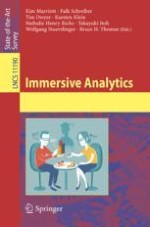2018 | Buch
Immersive Analytics
herausgegeben von: Kim Marriott, Prof. Falk Schreiber, Tim Dwyer, Karsten Klein, Nathalie Henry Riche, Takayuki Itoh, Wolfgang Stuerzlinger, Bruce H. Thomas
Verlag: Springer International Publishing
Buchreihe : Lecture Notes in Computer Science
